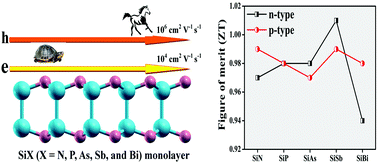Exploration of the strain and thermoelectric properties of hexagonal SiX (X = N, P, As, Sb, and Bi) monolayers†
Abstract
Materials with moderate bandgap, high carrier mobilities and high thermoelectric efficiencies show robust performance in microelectronic and thermoelectric applications. We investigated the structural, electronic and thermoelectric properties of Si-based group IV–V monolayers using density functional theory and the semi-classical Boltzmann transport theory. The electronic band structure of SiX monolayers calculated with the PBE functional indicates moderate band gap characteristics. All the studied systems are indirect band gap semiconductors except for SiBi. The electronic band gap of these monolayers increases initially up to a certain limit and then decreases, becoming metallic at higher strain. This suggests the possibility of tuning the electronic band gap by applying strain. Carrier mobility is calculated using the deformation potential theory to get the relaxation time. Remarkable values of carrier mobility indicate p-type semiconducting nature for SiN, SiP and SiBi, while SiAs and SiSb indicate n-type semiconducting nature. The maximum ZT values at 300 K of n-type SiSb and SiAs are 1.01 and 0.98, whereas for p-type SiN, SiP, and SiBi they are 0.99, 0.98, and 0.94, respectively. Higher Seebeck coefficients, higher power factors, and a lower value of electronic thermal conductivity could be achieved in these binary compounds. These findings indicate that the new two-dimensional hexagonal SiX (X = N, P, As, Sb, and Bi) systems are promising candidates for thermoelectric materials at room temperature.



 Please wait while we load your content...
Please wait while we load your content...